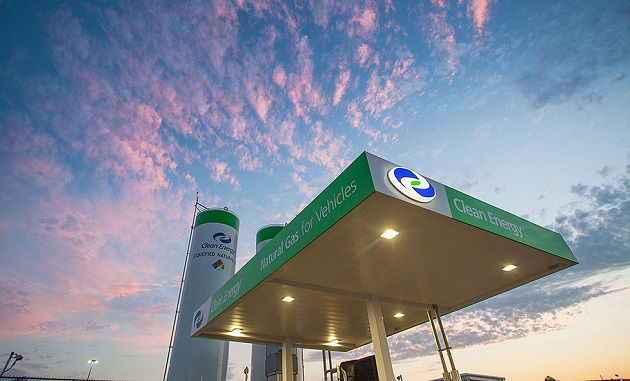
UPS will buy renewable gas from Clean Energy Fuels Corp. in California. (Photo from Clean Energy Fuels)
Biomethane is a drop in the ocean of fuel used in the U.S. shipping industry now, but its prospects improved a bit on Tuesday with the announcement of an agreement by UPS to buy “renewable natural gas” (RNG) from Clean Energy Fuels, the natural-gas-for-transport company co-founded by T. Boone Pickens.
UPS said that beginning this month, tractors and delivery vehicles that refuel at stations in Sacramento, Fresno and Los Angeles will annually use about 1.5 million gallon of the fuel, called Redeem.
Harrison Clay, who heads up the renewable fuels division for Clean Energy Fuels, told Breaking Energy that the company expects to sell about 40 million gallons of Redeem this year, up from 20 million gallons last year and 14 million in 2013, its first year on the market. “The UPS deal is a tremendous sign of where the market is headed,” Clay said.
While natural gas burns cleaner than diesel (and is about a dollar cheaper per gallon), giving it an apparent climate edge over the traditional transportation fuel, climate hawks are skeptical at best about its big-picture benefits. The issues that plague natural gas, however, like methane leakage and possible water contamination, don’t come into play with biomethane.
The fuel comes from the decomposition of organic waste – often at landfills or wastewater treatment plants, or big livestock operations using anaerobic digesters. If it isn’t captured, it would go into the atmosphere as a potent greenhouse gas. The captured gas is frequently flared, reducing its GHG potency, or used to produce electricity, but with added processing it can be fed into the natural gas grid and used in natural gas vehicles.
So those UPS trucks won’t necessarily run on fuel that was made directly from trash or cow poop, “but I have an obligation to deliver the energy content at the point of consumption,” Clay said.
In its listing of the carbon intensity of various fuels, the California Air Resources Board gives “Landfill gas (bio-methane) cleaned up to pipeline quality NG” its best rating, the equivalent of 11.26 grams of CO2 per megajoule, compared to 94.71 gCO2e/MJ for diesel and 67.70 for compressed natural gas.
Policy has created a big market for biomethane as a transportation fuel in Europe. “About 60% of the gas used in Sweden’s 38,500 natural gas vehicles is RNG,” according to the U.S. Department of Energy. “In Germany, 25% of the public compressed natural gas stations dispense 100% RNG.”

UPS trucks sit outside a UPS Customer Service Center on January 8, 2010 in Forest Park, Georgia. (Photo by Jessica McGowan/Getty Images)
The United States is lagging, although changes to the Renewable Fuel Standard last year improved biomethane’s prospects by qualifying it as an advanced cellulosic biofuel. Clean Energy Fuels, which sells Redeem for the same price as conventional natural gas, is focused mainly on California because the state has additional policy initiatives that can make the business viable there, Clay said: Its cap-and-trade program makes competing fuels more expensive, and a Low Carbon Fuel Standard Program is “one of the most advanced in the world,” according to the Renewable Natural Gas coalition.
Right now, that LCFS isn’t providing a huge market boost because the credit price is low, at $23 per metric ton according to the latest report from the California Air Resources Board. But the program began with modest targets that will become steeper – climbing gradually from a 1 percent emissions cut last year to 10 percent in 2020 – board member Daniel Sperling noted in a recent interview.
“As an academic, I will say it seems pretty likely the price is going to go up as we get to five and then 7.5 percent, and the market will get tighter. It’s just economics 101,” Sperling told John Kingston of the McGraw Hill Financial Global Institute, writing on Platts.
Also heartening for the biomethane cause: Gov. Jerry Brown’s recent executive order calling for an overall greenhouse gas reduction of 40 percent below 1990 levels by 2030.
“The price of the carbon is only going to go up,” Clay said, “as we drive down the emissions ceilings.”
How long it takes for that to happen is a big unknown, but Clay said Clean Energy Fuels, the first company to do RNG for commercial vehicles, is in it for the long haul. “This market is brand new,” he said. “Right now it’s a small business, and lumpy in both supply and demand. But we’re taking a 10 to 20 year view, and are confident that the carbon advantage that we offer will be attractive.”
UPS, which said it has a goal of “driving one billion miles using its alternative fuel and advanced technology fleet by the end of 2017,” was happy to nudge things along and claim the title of largest user of biomethane in the shipping industry.
“We will achieve this title by pumping renewable natural gas into Class 8 heavy-duty trucks and delivery vehicles,” the company said in a blog post. “Although RNG has been available for several years, there’s been little demand for it in heavy duty Class 8 trucking in the U.S. We believe we can change that by leveraging our existing natural gas infrastructure and using our 2,300 natural gas vehicles to stimulate the production of transportation-quality RNG.”
To take advantage of the environmental benefits and fuel-cost differential between diesel and natural gas, UPS has invested heavily: A Class 8 18-wheeler that can burn RNG (or standard natural gas) now goes for about $65,000 more than a diesel truck, the company says.
